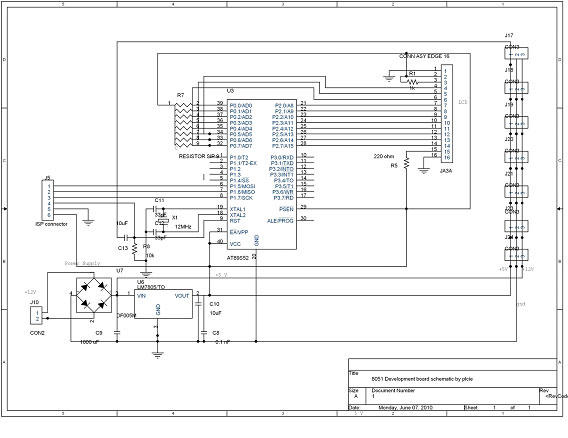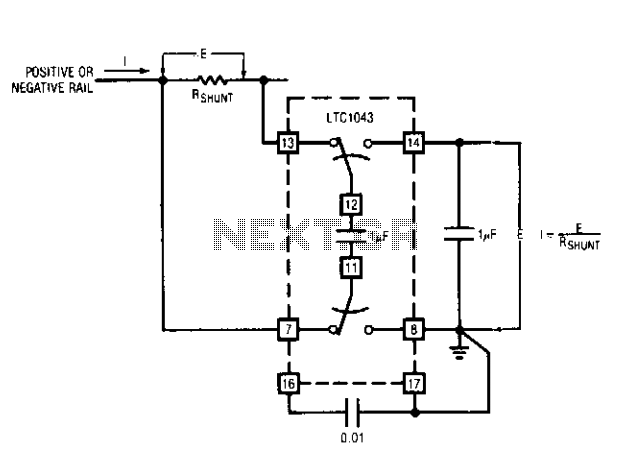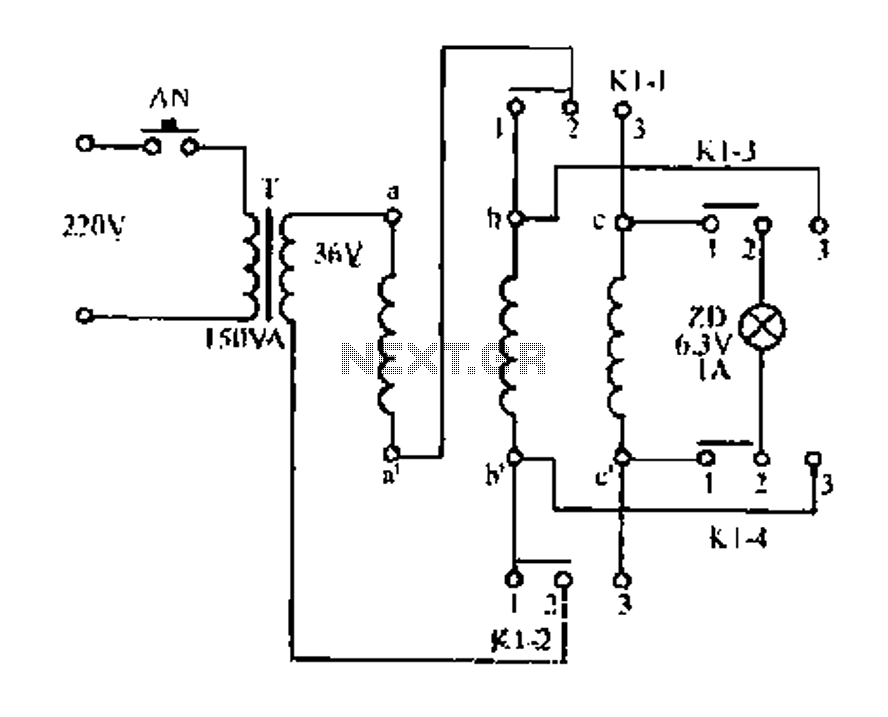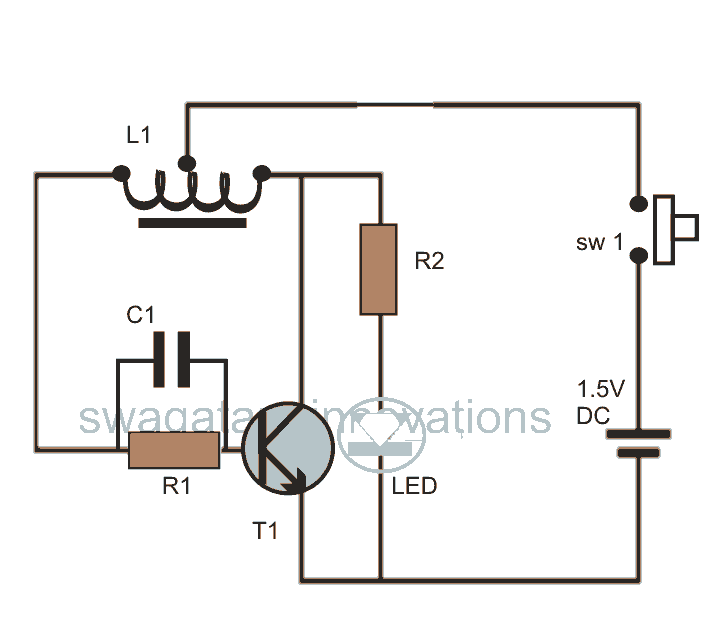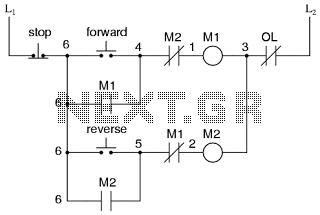
hobby power supply circuit
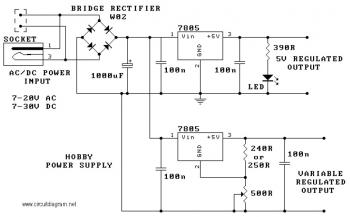
The circuit utilizes the 7805 voltage regulator, which features three connections: input, output, and ground. It delivers a fixed output voltage, with the last two digits of the part number indicating the specific output voltage, such as 05, 06, 08, 10, 12, 15, 18, or 24 volts. The 7800 series can supply up to 1 amp of load current and includes integrated circuitry that disables the regulator to prevent damage if it is operated outside its designated safe operating area. In the event of overheating, the chip should be allowed to cool down and a heatsink should be attached.
The 7805 voltage regulator is a linear voltage regulator widely used in electronic circuits to provide a stable output voltage. It is part of the 7800 series of voltage regulators, which are known for their reliability and ease of use. The device operates by taking a higher input voltage and converting it to a lower, regulated output voltage. The three terminals of the 7805 are configured as follows: the input pin receives the unregulated voltage, the output pin delivers the regulated voltage, and the ground pin serves as a reference point for the circuit.
The output voltage of the 7805 is fixed at 5V, making it suitable for powering microcontrollers, sensors, and other low-voltage devices. The regulator can handle input voltages up to 35V, providing a significant voltage drop across the device while maintaining a stable output. Its maximum output current rating is 1 amp, which is adequate for many applications. However, it is essential to ensure that the load does not exceed this current limit to prevent overheating and potential damage to the regulator.
Thermal management is crucial when using the 7805. The built-in thermal shutdown feature protects the device from overheating by shutting it down if the junction temperature exceeds safe limits. To enhance heat dissipation, it is advisable to attach a heatsink to the regulator, especially in applications where it may be subjected to high load currents or elevated ambient temperatures. Proper layout and design considerations, such as ensuring adequate airflow and using appropriate trace widths on printed circuit boards, will further aid in maintaining optimal operating conditions.
In summary, the 7805 voltage regulator is a versatile component that provides a reliable means of regulating voltage in electronic circuits. Its simple design, coupled with built-in protection features, makes it a preferred choice for many engineers and hobbyists alike.The circuit is based around the 7805 voltage regulator. It has only 3 connections (input, output and ground) and it provides a fixed output. The last two digits of the part number specify the output voltage, eg. 05, 06, 08, 10, 12, 15, 18, or 24. The 7800 series provides up to 1 amp load current and has on-chip circuitry to shut down the regulator (rather than blowing out) if any attempt is made to operate it outside its safe operating area. (If this happens to you, let the chip cool down & attach the heatsink. ) 🔗 External reference
The 7805 voltage regulator is a linear voltage regulator widely used in electronic circuits to provide a stable output voltage. It is part of the 7800 series of voltage regulators, which are known for their reliability and ease of use. The device operates by taking a higher input voltage and converting it to a lower, regulated output voltage. The three terminals of the 7805 are configured as follows: the input pin receives the unregulated voltage, the output pin delivers the regulated voltage, and the ground pin serves as a reference point for the circuit.
The output voltage of the 7805 is fixed at 5V, making it suitable for powering microcontrollers, sensors, and other low-voltage devices. The regulator can handle input voltages up to 35V, providing a significant voltage drop across the device while maintaining a stable output. Its maximum output current rating is 1 amp, which is adequate for many applications. However, it is essential to ensure that the load does not exceed this current limit to prevent overheating and potential damage to the regulator.
Thermal management is crucial when using the 7805. The built-in thermal shutdown feature protects the device from overheating by shutting it down if the junction temperature exceeds safe limits. To enhance heat dissipation, it is advisable to attach a heatsink to the regulator, especially in applications where it may be subjected to high load currents or elevated ambient temperatures. Proper layout and design considerations, such as ensuring adequate airflow and using appropriate trace widths on printed circuit boards, will further aid in maintaining optimal operating conditions.
In summary, the 7805 voltage regulator is a versatile component that provides a reliable means of regulating voltage in electronic circuits. Its simple design, coupled with built-in protection features, makes it a preferred choice for many engineers and hobbyists alike.The circuit is based around the 7805 voltage regulator. It has only 3 connections (input, output and ground) and it provides a fixed output. The last two digits of the part number specify the output voltage, eg. 05, 06, 08, 10, 12, 15, 18, or 24. The 7800 series provides up to 1 amp load current and has on-chip circuitry to shut down the regulator (rather than blowing out) if any attempt is made to operate it outside its safe operating area. (If this happens to you, let the chip cool down & attach the heatsink. ) 🔗 External reference
Warning: include(partials/cookie-banner.php): Failed to open stream: Permission denied in /var/www/html/nextgr/view-circuit.php on line 713
Warning: include(): Failed opening 'partials/cookie-banner.php' for inclusion (include_path='.:/usr/share/php') in /var/www/html/nextgr/view-circuit.php on line 713
